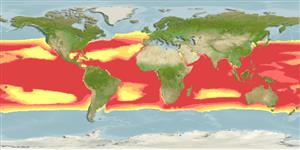Environment: milieu / climate zone / depth range / distribution range
Ecologie
marien; oceanodroom (Ref. 51243); diepte ? - 200 m (Ref. 86942). Subtropical
Worldwide in warm seas. Western Indian Ocean: including Reunion and Mauritius (Ref. 33390). Eastern Pacific: off San Francisco in California, USA to Chile, but rare north of Baja California in Mexico. Western Atlantic: Florida in USA and Gulf of Mexico to Brazil (Ref. 7251). Eastern Central Atlantic: St. Paul's Rocks (Ref. 13121).
Grootte / Gewicht / Leeftijd
Maturity: Lm ? range ? - ? cm
Max length : 30.0 cm SL mannelijk / geslacht onbekend; (Ref. 5288)
Dorsale stekels (totaal): 0; Dorsale zachte stralen (totaal): 17-22; Anale stekels 0; Anale zachte stralen: 21 - 26. Pale grey to white in color.
Host specific on manta rays, but occasionally attaches to sharks. Often occurs inside gill chamber and mouth of host. Also attaches itself to black marlin, Makaira indica, of the Indo-Pacific Region (Ref. 7251). Rarely free-swimming (Ref. 10791). Used in Chinese medicine (Ref. 12166).
Levenscyclus en paargedrag
Maturiteit | Voortplanting | Paaien | Eieren | Fecunditeit | Larven
Gray, K.N., J.R. McDowell, B.B. Collette and J.E. Graves, 2009. A molecular phylogeny of the remoras and their relatives. Bull. Mar. Sci. 84(2):183-198. (Ref. 86676)
Status op de Rode Lijst van het IUCN (Ref. 130435)
Gevaar voor de mens
Harmless
Gebruik door de mens
Meer informatie
Lokale namenSynoniemenMetabolismePredatorenEcotoxicologieVoortplantingMaturiteitPaaienPaaiaggregatiesFecunditeitEierenOntwikkeling van de eieren
ReferentiesAquacultuurAquacultuurprofielKweeklijnenGeneticaElectrophoresesErfelijkheidZiektesVerwerkingNutrientsMassaconversie
Tools
Speciale rapporten
Download XML
Internetbronnen
Estimates based on models
Preferred temperature (Ref.
123201): 16.7 - 28.2, mean 25.7 °C (based on 1829 cells).
Fylogenetische diversiteitsindex (Ref.
82804): PD
50 = 0.5352 [Uniqueness, from 0.5 = low to 2.0 = high].
Bayesian length-weight: a=0.00263 (0.00112 - 0.00620), b=3.17 (2.96 - 3.38), in cm total length, based on LWR estimates for this (Sub)family-body shape (Ref.
93245).
Trofisch niveau (Ref.
69278): 3.4 ±0.4 se; based on size and trophs of closest relatives
Weerstandsvermogen (Ref.
120179): Gemiddeld, minimale populatieverdubbelingstijd 1,4-4,4 jaar (Assuming Fec < 10,000).
Fishing Vulnerability (Ref.
59153): Low to moderate vulnerability (27 of 100).
